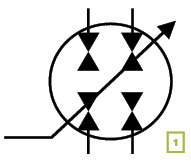
Fluid power has become a vital component in our ability to perform work: it harvests our crops, takes our waste to the landfill, moves the landing gear, entertains and protects us, and all with a power density and flexibility that is unmatched in any other power transfer system. However, when it comes to efficiency, fluid power systems are not very high on the list. This article series will ask us to think differently about our fluid power systems. We will look at energy in a different way and discover ways to transform fluid power energy to make our systems more efficient, and then be able to make better use of the new and improved components available to us.
I’m not really saying it’s like a butterfly emerging from its cocoon, but I kind of like the metaphor. The lowly, often neglected, displacement flow divider is about to morph into something new that can dramatically change the way we think about and apply fluid power.
In “Flow Means ‘Go’… Well Not Exactly” (September/October 2016 issue), we discussed the need to think differently about the relationship between pressure and flow.
In “My Torque Isn’t Working” (Tech Directory 2016 issue), we discussed combining volume, flow, and pressure so that they can be viewed in terms of energy units or units of power. We then saw how this would aid in our qualifying and quantifying the efficiency of our fluid power systems.
In “If Motors Could Torque” (November/December 2016 issue), we re-examined the power formula to allow RPM to be the controlling factor. We saw how a properly controlled, variable-displacement motor could maintain a controlled RPM under varying loads without the use of a restrictive flow control. Multiple motors under continuously varying loads, being supplied from a common source, would each only draw the energy needed for the work being done at each moment.
In “Divide and Conquer” (January/February 2017 issue), we looked closely at the old technology of the displacement flow dividers, which we dubbed “pressure/flow transformers.” We saw how they can consume less energy than restrictive flow dividers because all the energy is being used to either do work directly or to assist in driving section(s) that carry a greater load. We also saw how they inherently divide and combine the energy units of flow and pressure. This is good for the synchronization of actuators, but also allows for pressure intensification and flow augmentation.
Thinking in terms of “flow means go,” we usually think of flow as controlling speed. We often interchange the terms of “speed control” and “flow control.” We need to think differently. When we control the speed of an actuator, we are really providing power control. Increasing the speed of a constant load means increasing the rate at which we supply energy units. We looked at this in detail when we used the variable-displacement motor with RPM control. To adjust the speed under a constant load, we changed the input rate of energy units. It is important to note that there needed to be a variable energy source, as well as a variable-displacement actuator to make this work efficiently. However, most fluid power applications do not use variable-displacement actuators. Most motors, and all cylinders, have a fixed volume for each revolution or stroke.
Now, a pressure/flow transformer is not really a flow control; it is a flow divider/combiner. It splits or combines flow in proportion to the ratios of the displacement sections. This is why some people refer to them as “flow proportioners.” They do not limit flow, but merely proportion whatever flow is passing through. What is needed is a way to use the transforming powers of the pressure/flow divider to mold the transfer of energy in a way that will provide true energy control, not just flow control.
What is emerging out of its historical cocoon is a new displacement device that enables us to let each actuator draw only the energy units needed for the work being done. When we think of power as a rate of energy unit input, we can see how controlling that energy can provide speed control without the use of restrictive flow controls.
Introducing the Variable-Displacement Transformer (VDT)
 The VDT is simply a single, two-chamber, positive-displacement device with the displacement of each chamber dependent on the displacement of the other. It is placed in the fluid stream in such a way as to divide or combine energy units, much like the pressure/flow transformers in the previous article, only with infinite variability. It can proportion the energy into a 100% to 0% ratio, a 0% to 100% ratio, or anything in between. The suggested symbol in Fig. 1 shows a single rotary device with two chambers. Each one is dependent on the other, and each one can be driven by or drive the fluid energy passing through it. It is also infinitely variable.
The VDT is simply a single, two-chamber, positive-displacement device with the displacement of each chamber dependent on the displacement of the other. It is placed in the fluid stream in such a way as to divide or combine energy units, much like the pressure/flow transformers in the previous article, only with infinite variability. It can proportion the energy into a 100% to 0% ratio, a 0% to 100% ratio, or anything in between. The suggested symbol in Fig. 1 shows a single rotary device with two chambers. Each one is dependent on the other, and each one can be driven by or drive the fluid energy passing through it. It is also infinitely variable.
This is valuable, even if it is only used as an adjustable flow divider for use in synchronizing actuators with varying displacements. But there is much more that can be done with this device. We can use it as an actuator speed control. It can allow us to limit the energy units taken from the source to what is actually needed for power.
https://fluidpowerjournal.com/2017/02/transformation-complete/